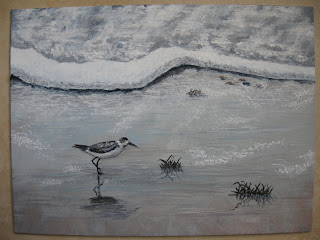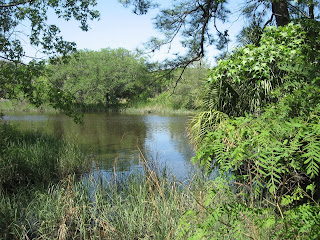

 I first showed you this painting about six months ago and am repeating that post for newer readers. Two photos show portions of the painting for more detail (and as always, you can click on a photo to enlarge it). Once again, the location is a spot that many people would walk by without stopping to look. A small bridge on Hogan Road crosses Little Pottsburg Creek near our home on the south side of Jacksonville, Florida. On the lookout for scenes with water features, I pulled over to explore and was especially taken with the view in one direction, where the creek widened and curved out of sight around a bend. A thickly wooded bank on one side was countered by oddly charming, spindly trees rising above bushes on the other. The trees reminded me of children experiencing a sudden growth spurt practicing in dance class, somehow combining awkwardness and grace.
I first showed you this painting about six months ago and am repeating that post for newer readers. Two photos show portions of the painting for more detail (and as always, you can click on a photo to enlarge it). Once again, the location is a spot that many people would walk by without stopping to look. A small bridge on Hogan Road crosses Little Pottsburg Creek near our home on the south side of Jacksonville, Florida. On the lookout for scenes with water features, I pulled over to explore and was especially taken with the view in one direction, where the creek widened and curved out of sight around a bend. A thickly wooded bank on one side was countered by oddly charming, spindly trees rising above bushes on the other. The trees reminded me of children experiencing a sudden growth spurt practicing in dance class, somehow combining awkwardness and grace.
This is the second painting to emerge from photos taken that day. I decided to push myself away from my favorite palette and began with a pinkish sky. Although the sky was actually a pale overcast grey, the pink tones somehow captured the bright, warm haze of that morning--the kind of light that requires sunglasses in spite of pervasive cloud cover. One painting goal was to let the sky set a certain mood and to continue experimenting with a limited palette of ultramarine blue, cerulean blue, Paynes grey, cadmium red deep, burnt sienna, yellow ochre, and white. All greens, browns, and blackish tones are mixed from these colors. The second painting goal was to try to evoke the tranquility of the moment and the feeling of mystery as the creek glided around a bend and out of sight. The reflections in the water seemed central to portraying the stillness of the scene.
As usual, pursuing the goals of this piece gave me fits along the way, and it was even more difficult than usual to decide when to stop revising and to declare the painting finished. For some reason, I continued to tinker with small details, to wish it looked a bit different (but not knowing precisely what to change), and to put it away repeatedly to pull out days later for more tinkering. Of course, this can be the ruin of a decent creation, and I finally had to exert some self-discipline and just STOP. Have you seen news features about chimps, elephants, or other non-human animals who paint amazing abstracts? One commentator remarked that the unseen co-artist is the person who pulls their work away and gives them a fresh canvas. Left to themselves, they would happily continue slapping on more and more paint--producing, presumably, a less interesting result. I can definitely relate to the chimps who might not be the best judges of when to stop painting. However this piece, now signed and finished with a light coat of medium, has been declared officially complete and has hung on our bedroom wall for a few weeks. And, as it catches my eye in lamplight or as morning brightens, it has definitely grown on me. Update since the first time I posted this: This painting and several others are now available at a lovely local shop in the San Marco section of Jacksonville, Trends Home Decor. If you visit there, you will be amazed at the variety of distinctive art, home accessories, and furniture at affordable prices.
Question: What experiences have you had with the art of knowing when to stop?





























